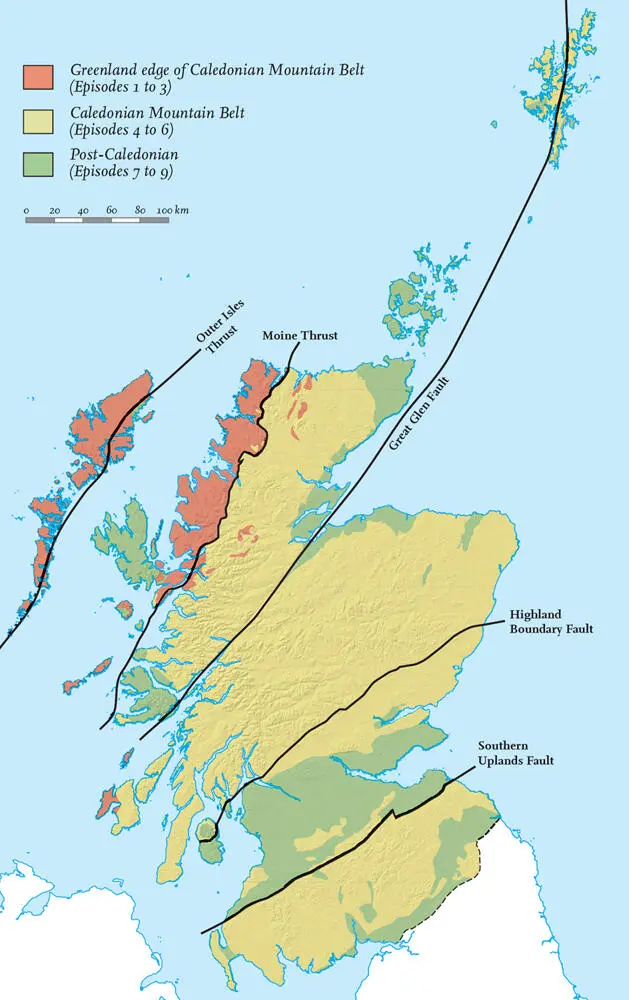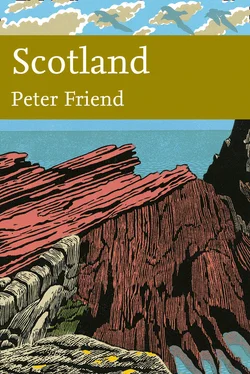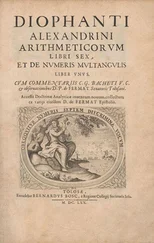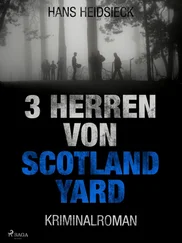1 ...6 7 8 10 11 12 ...24 
FIG 22. The distribution of the Pre-, Syn- and Post-Caledonian rocks in Scotland.
FIG 23. Aerial oblique view of Suilven (731 m), carved from Neoproterozoic Torridonian Sandstones resting unconformably on the knock-and-lochan topography of the Lewisian Complex. (© Adrian Warren/lastrefuge.co.uk)
Episode 2: formation of the Torridonian Sandstones
Mountains and slopes made of uniform but well-layered successions of Torridonian Sandstones, often tens to hundreds of metres thick, provide some highly characteristic elements of the Hebridean terrane ( Fig. 23). The layers are generally rather flat-lying, except in the folded and faulted bedrock of the Moine Thrust Zone where the Torridonian has been deformed along the eastern terrane boundary. Careful examination of the layering shows that it generally reflects episodes in the life of Torridonian rivers, which occasionally flooded and deposited sandy or gravelly river bars, often with muddy tops that have weathered to pick out the layers . Although much of the Torridonian was deposited by rivers, some of it accumulated in lakes or in the sea.
At least two different episodes of deposition are represented in the Torridonian Sandstones, and these have been dated, using radiometric methods, as Mesoproterozoic and Neoproterozoic (1.2 and 1.0 – 0.95 billion years ago respectively: Fig. 21). These two episodes left thick successions of sediment in the crustal record: up to 2 km in the Mesoproterozoic and up to 5 km in the Neoproterozoic. Thicknesses as great as these imply the downward movement of certain areas (basins) of the Earth’s surface close to areas where erosion due to upward movement was producing large quantities of sediment. In other words, although the Torridonian Sandstones are the result of modification by surface processes, these processes must have been linked to important vertical movements of the crust, due to forces acting within the Earth.
FIG 24. Cross-section through the Ord window of Southern Skye, showing the folded and fractured structure of the bedrock below the Moine Thrust.
The contact between the flat-lying layering of the Torridonian and the underlying Lewisian Complex is an unconformity that formed when the Torridonian sediments were deposited onto topography of valleys and hills (often hundreds of metres in relief) that had been carved in the Lewisian Complex. This unconformity, although preserving local Proterozoic hills and valleys, is relatively flat-lying overall, showing that widespread vertical movements – rather than significant folding or tilting – must have been involved.
The western and eastern margins of the present-day Atlantic Ocean were close to one another within a ‘super’-continent when the Torridonian sediments were accumulating. It seems likely that much of the sediment was derived from upland areas whose crust is now in Greenland or eastern Canada.
Episode 3: Cambrian and Ordovician sedimentation
A rather uniform succession of sediments of Cambrian and Ordovician age occurs more or less continuously along a strip from Skye, in the south, to the north coast of the Scottish mainland ( Figs 19, 20, 22: our ‘Greenland edge’). This succession was deposited unconformably on the eroded rocks of the Lewisian Complex and the Torridonian Sandstones. These Cambrian and Ordovician sediments only occur in the Hebridean terrane, and their usually gentle tilt is evidence of the lack of later movements, although they have been folded and fractured in the Moine Thrust Zone along the terrane’s edge ( Fig. 24).
Where most fully developed, this sedimentary succession is about 1 km in thickness and consists of a lower unit of quartzites (up to 100 m thick) that forms a greyish-white cap on some mountains and weathers to produce distinctive angular scree and boulder fields. Above this is a thin unit of mudstones, fractured and folded by subsequent movements on the Moine Thrust, overlain by a thick succession of limestones which, according to the fossil evidence contained within them, span the time interval from early Cambrian to early Ordovician ( Fig. 21). In the present-day landscape, these limestones often produce swallow holes and caves formed by solution of the limestone’s fracture joints, as well as unusually lush grass wherever there is significant soil development.
The whole of this succession appears to have formed on the edge of a sea, and the occurrence of similar sediments on both sides of the present-day North Atlantic, a much more recent feature of the Earth’s surface, suggests a widespread uniformity in the coastal environments at this time. It is believed that these deposits formed due to surface modification involving global sea-level change, with no clear evidence of local movements due to processes deeper within the Earth.
CALEDONIAN MOUNTAIN-BUILDING EPISODES
The Latin adjective Caledonian is widely used to indicate Scottish-ness, and is used in geology for the important phase of mountain building that dominated earth movements and surface modification in Scotland between Ordovician and Devonian times. Evidence of similar movements and modifications during the same time periods is found along the east coast of the USA, Canada and Greenland, and through Ireland, Norway, Sweden and Spitsbergen. The terranes now recognised in Scotland have been mentioned above and shown in Figure 20. Distinct areas of continental crust, some thousands of kilometres across, others much smaller, rode on plates ( Chapter 3) that moved independently and came together at different stages over Ordovician, Silurian and Devonian times to create the final assemblage of crustal fragments now present in Scotland. The main crustal fragments and their plates and intervening oceans are tracked in summary in Figure 25.
Episode 4: making the core of the Caledonian mountains
The core of the Caledonian mountain belt is represented by the metamorphic bedrock that forms most of the Northern Highland and Grampian Highland terranes ( Fig. 20). The metamorphism of the originally largely sedimentary rocks occurred under the high pressures and temperatures that reflect their deep burial when compressive movements caused thickening of the crust and mountain uplift at the surface.
For many years a distinction has been drawn between the Moine and Dalradian supergroups in the mapping of the metamorphic core of the Caledonian mountain belt ( Figs 19and 20). The Moine Supergroup was named after a stretch of moorland on the north coast. It forms most of the Northern Highland terrane and may be present also in part of the Grampian Highland Terrane ( Fig. 19). In contrast, the Dalradian Supergroup contains a greater variety of metamorphic rock types that have made it possible to trace distinctive subdivisions across most of the rest of the Grampian Highland terrane and even into Shetland. The name Dalradian has many historic roots and, in a geological sense it simply indicates association with the Scottish Highlands and parts of Ireland. There is general agreement that the original (pre-metamorphism) sediments of the Moine are older than those of the Dalradian, but the mapping of any boundary between them is still very arbitrary, and is not important in our review of landscapes across Scotland.
FIG 25. Diagram showing major plate-scale ocean closings and openings, with compressive events on the plate margins that generated events during the Caledonian and later Variscan mountain building. Ma (mega-annum) = million years ago.
The dominant bedrock of both these supergroups is metamorphic. In other words, the bedrock has been altered but not melted, during the growth of new minerals under the high temperatures and/or pressures generated by compressive movements and thickening of the crust. The original rocks of the Moine and Dalradian were mostly formed as sediments, mainly muds and sands but also occasionally lime-rich sediments. These sediments have now been transformed into schists (also called pelites; originally mudstones) and psammites (originally sandstones).
Читать дальше













